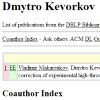| |
 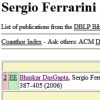  
Bhaskar DasGupta,
Sergio Ferrarini,
Uthra Gopalakrishnan and
Nisha Raj Paryani. Inapproximability results for the lateral gene transfer problem. In JCO, Vol. 11(4):387-405, 2006.
Keywords: approximation, from rooted trees, from species tree, inapproximability, lateral gene transfer, parsimony, phylogenetic network, phylogeny.
Note: http://www.cs.uic.edu/~dasgupta/resume/publ/papers/t-scenario-3-reviewed-3.pdf.
|
|
| |
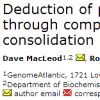 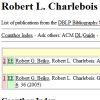  
Dave MacLeod,
Robert L. Charlebois,
W. Ford Doolittle and
Eric Bapteste. Deduction of probable events of lateral gene transfer through comparison of phylogenetic trees by recursive consolidation and rearrangement. In BMCEB, Vol. 5(27), 2005.
Keywords: explicit network, from rooted trees, lateral gene transfer, phylogenetic network, phylogeny, Program HorizStory, reconstruction, software.
Note: http://dx.doi.org/10.1186/1471-2148-5-27.
Toggle abstract
"Background: When organismal phylogenies based on sequences of single marker genes are poorly resolved, a logical approach is to add more markers, on the assumption that weak but congruent phylogenetic signal will be reinforced in such multigene trees. Such approaches are valid only when the several markers indeed have identical phylogenies, an issue which many multigene methods (such as the use of concatenated gene sequences or the assembly of supertrees) do not directly address. Indeed, even when the true history is a mixture of vertical descent for some genes and lateral gene transfer (LGT) for others, such methods produce unique topologies. Results: We have developed software that aims to extract evidence for vertical and lateral inheritance from a set of gene trees compared against an arbitrary reference tree. This evidence is then displayed as a synthesis showing support over the tree for vertical inheritance, overlaid with explicit lateral gene transfer (LGT) events inferred to have occurred over the history of the tree. Like splits-tree methods, one can thus identify nodes at which conflict occurs. Additionally one can make reasonable inferences about vertical and lateral signal, assigning putative donors and recipients. Conclusion: A tool such as ours can serve to explore the reticulated dimensionality of molecular evolution, by dissecting vertical and lateral inheritance at high resolution. By this, we mean that individual nodes can be examined not only for congruence, but also for coherence in light of LGT. We assert that our tools will facilitate the comparison of phylogenetic trees, and the interpretation of conflicting data. © 2005 MacLeod et al; licensee BioMed Central Ltd."
|
|
| |
 
Robert G. Beiko and
Nicholas Hamilton. Phylogenetic identification of lateral genetic transfer events. In BMCEB, Vol. 6(15), 2006.
Keywords: evaluation, from rooted trees, from unrooted trees, lateral gene transfer, Program EEEP, Program HorizStory, Program LatTrans, reconstruction, software, SPR distance.
Note: http://dx.doi.org/10.1186/1471-2148-6-15.
Toggle abstract
"Background: Lateral genetic transfer can lead to disagreements among phylogenetic trees comprising sequences from the same set of taxa. Where topological discordance is thought to have arisen through genetic transfer events, tree comparisons can be used to identify the lineages that may have shared genetic information. An 'edit path' of one or more transfer events can be represented with a series of subtree prune and regraft (SPR) operations, but finding the optimal such set of operations is NP-hard for comparisons between rooted trees, and may be so for unrooted trees as well. Results: Efficient Evaluation of Edit Paths (EEEP) is a new tree comparison algorithm that uses evolutionarily reasonable constraints to identify and eliminate many unproductive search avenues, reducing the time required to solve many edit path problems. The performance of EEEP compares favourably to that of other algorithms when applied to strictly bifurcating trees with specified numbers of SPR operations. We also used EEEP to recover edit paths from over 19 000 unrooted, incompletely resolved protein trees containing up to 144 taxa as part of a large phylogenomic study. While inferred protein trees were far more similar to a reference supertree than random trees were to each other, the phylogenetic distance spanned by random versus inferred transfer events was similar, suggesting that real transfer events occur most frequently between closely related organisms, but can span large phylogenetic distances as well. While most of the protein trees examined here were very similar to the reference supertree, requiring zero or one edit operations for reconciliation, some trees implied up to 40 transfer events within a single orthologous set of proteins. Conclusion: Since sequence trees typically have no implied root and may contain unresolved or multifurcating nodes, the strategy implemented in EEEP is the most appropriate for phylogenomic analyses. The high degree of consistency among inferred protein trees shows that vertical inheritance is the dominant pattern of evolution, at least for the set of organisms considered here. However, the edit paths inferred using EEEP suggest an important role for genetic transfer in the evolution of microbial genomes as well. © 2006Beiko and Hamilton; licensee BioMed Central Ltd."
|
|
| |
 
Maria S. Poptsova and
J. Peter Gogarten. The power of phylogenetic approaches to detect horizontally transferred genes. In BMCEB, Vol. 7(45), 2007.
Keywords: evaluation, from rooted trees, lateral gene transfer, Program EEEP.
Note: http://dx.doi.org/10.1186/1471-2148-7-45.
Toggle abstract
"Background. Horizontal gene transfer plays an important role in evolution because it sometimes allows recipient lineages to adapt to new ecological niches. High genes transfer frequencies were inferred for prokaryotic and early eukaryotic evolution. Does horizontal gene transfer also impact phylogenetic reconstruction of the evolutionary history of genomes and organisms? The answer to this question depends at least in part on the actual gene transfer frequencies and on the ability to weed out transferred genes from further analyses. Are the detected transfers mainly false positives, or are they the tip of an iceberg of many transfer events most of which go undetected by current methods? Results. Phylogenetic detection methods appear to be the method of choice to infer gene transfers, especially for ancient transfers and those followed by orthologous replacement. Here we explore how well some of these methods perform using in silico transfers between the terminal branches of a gamma proteobacterial, genome based phylogeny. For the experiments performed here on average the AU test at a 5% significance level detects 90.3% of the transfers and 91% of the exchanges as significant. Using the Robinson-Foulds distance only 57.7% of the exchanges and 60% of the donations were identified as significant. Analyses using bipartition spectra appeared most successful in our test case. The power of detection was on average 97% using a 70% cut-off and 94.2% with 90% cut-off for identifying conflicting bipartitions, while the rate of false positives was below 4.2% and 2.1% for the two cut-offs, respectively. For all methods the detection rates improved when more intervening branches separated donor and recipient. Conclusion. Rates of detected transfers should not be mistaken for the actual transfer rates; most analyses of gene transfers remain anecdotal. The method and significance level to identify potential gene transfer events represent a trade-off between the frequency of erroneous identification (false positives) and the power to detect actual transfer events. © 2007 Poptsova and Gogarten; licensee BioMed Central Ltd."
|
|
| |
|
| |
 
Roderic D.M. Page and
Michael A. Charleston. Trees within trees: phylogeny and historical associations. In TEE, Vol. 13(9):356-359, 1998.
Keywords: duplication, explicit network, from rooted trees, from species tree, lateral gene transfer, phylogenetic network, phylogeny, reconstruction, survey.
Note: http://taxonomy.zoology.gla.ac.uk/rod/papers/tree.pdf.
|
|
| |
   
Cuong Than,
Derek Ruths,
Hideki Innan and
Luay Nakhleh. Confounding Factors in HGT Detection: Statistical Error, Coalescent Effects, and Multiple Solutions. In JCB, Vol. 14(4):517-535, 2007.
Keywords: counting, explicit network, from rooted trees, from species tree, lateral gene transfer, phylogenetic network, phylogeny, Program LatTrans, Program PhyloNet.
Note: http://www.cs.rice.edu/~nakhleh/Papers/recombcg06-jcb.pdf.
|
|
| |
 
Sagi Snir and
Tamir Tuller. The NET-HMM approach: Phylogenetic Network Inference by Combining Maximum Likelihood and Hidden Markov Models. In JBCB, Vol. 7(4):625-644, 2009.
Keywords: explicit network, from sequences, HMM, lateral gene transfer, likelihood, phylogenetic network, phylogeny, statistical model.
Note: http://research.haifa.ac.il/~ssagi/published%20papers/Snir-NET-HMM-JBCB-2009.pdf.
Toggle abstract
"Horizontal gene transfer (HGT) is the event of transferring genetic material from one lineage in the evolutionary tree to a different lineage. HGT plays a major role in bacterial genome diversification and is a significant mechanism by which bacteria develop resistance to antibiotics. Although the prevailing assumption is of complete HGT, cases of partial HGT (which are also named chimeric HGT) where only part of a gene is horizontally transferred, have also been reported, albeit less frequently. In this work we suggest a new probabilistic model, the NET-HMM, for analyzing and modeling phylogenetic networks. This new model captures the biologically realistic assumption that neighboring sites of DNA or amino acid sequences are not independent, which increases the accuracy of the inference. The model describes the phylogenetic network as a Hidden Markov Model (HMM), where each hidden state is related to one of the network's trees. One of the advantages of the NET-HMM is its ability to infer partial HGT as well as complete HGT. We describe the properties of the NET-HMM, devise efficient algorithms for solving a set of problems related to it, and implement them in software. We also provide a novel complementary significance test for evaluating the fitness of a model (NET-HMM) to a given dataset. Using NET-HMM, we are able to answer interesting biological questions, such as inferring the length of partial HGT's and the affected nucleotides in the genomic sequences, as well as inferring the exact location of HGT events along the tree branches. These advantages are demonstrated through the analysis of synthetical inputs and three different biological inputs. © 2009 Imperial College Press."
|
|
| |
  
Simone Linz,
Charles Semple and
Tanja Stadler. Analyzing and reconstructing reticulation networks under timing constraints. In JOMB, Vol. 61(5):715-737, 2010.
Keywords: explicit network, from rooted trees, hybridization, lateral gene transfer, NP complete, phylogenetic network, phylogeny, reconstruction, time consistent network.
Note: http://dx.doi.org/10.1007/s00285-009-0319-y..
Toggle abstract
"Reticulation networks are now frequently used to model the history of life for various groups of species whose evolutionary past is likely to include reticulation events such as horizontal gene transfer or hybridization. However, the reconstructed networks are rarely guaranteed to be temporal. If a reticulation network is temporal, then it satisfies the two biologically motivated timing constraints of instantaneously occurring reticulation events and successively occurring speciation events. On the other hand, if a reticulation network is not temporal, it is always possible to make it temporal by adding a number of additional unsampled or extinct taxa. In the first half of the paper, we show that deciding whether a given number of additional taxa is sufficient to transform a non-temporal reticulation network into a temporal one is an NP-complete problem. As one is often given a set of gene trees instead of a network in the context of hybridization, this motivates the second half of the paper which provides an algorithm, called TemporalHybrid, for reconstructing a temporal hybridization network that simultaneously explains the ancestral history of two trees or indicates that no such network exists. We further derive two methods to decide whether or not a temporal hybridization network exists for two given trees and illustrate one of the methods on a grass data set. © 2009 The Author(s)."
|
|
| |
  
Tal Dagan,
Yael Artzy-Randrup and
William Martin. Modular networks and cumulative impact of lateral transfer in prokaryote genome evolution. In PNAS, Vol. 105:10039-10044, 2008.
Keywords: from sequences, from species tree, heuristic, lateral gene transfer, phylogenetic network, phylogeny, reconstruction.
Note: http://dx.doi.org/10.1073/pnas.0800679105.
Toggle abstract
"Lateral gene transfer is an important mechanism of natural variation among prokaryotes, but the significance of its quantitative contribution to genome evolution is debated. Here, we report networks that capture both vertical and lateral components of evolutionary history among 539,723 genes distributed across 181 sequenced prokaryotic genomes. Partitioning of these networks by an eigenspectrum analysis identifies community structure in prokaryotic gene-sharing networks, the modules of which do not correspond to a strictly hierarchical prokaryotic classification. Our results indicate that, on average, at least 81 ± 15% of the genes in each genome studied were involved in lateral gene transfer at some point in their history, even though they can be vertically inherited after acquisition, uncovering a substantial cumulative effect of lateral gene transfer on longer evolutionary time scales. © 2008 by The National Academy of Sciences of the USA."
|
|
| |
  
Ali Tofigh,
Mike Hallett and
Jens Lagergren. Simultaneous Identification of Duplications and Lateral Gene Transfers. In TCBB, Vol. 8(2):517-535, 2011.
Keywords: duplication, explicit network, FPT, from rooted trees, from species tree, lateral gene transfer, loss, NP complete, phylogenetic network, phylogeny, reconstruction.
Note: http://dx.doi.org/10.1109/TCBB.2010.14.
Toggle abstract
"The incongruency between a gene tree and a corresponding species tree can be attributed to evolutionary events such as gene duplication and gene loss. This paper describes a combinatorial model where so-called DTL-scenarios are used to explain the differences between a gene tree and a corresponding species tree taking into account gene duplications, gene losses, and lateral gene transfers (also known as horizontal gene transfers). The reasonable biological constraint that a lateral gene transfer may only occur between contemporary species leads to the notion of acyclic DTL-scenarios. Parsimony methods are introduced by defining appropriate optimization problems. We show that finding most parsimonious acyclic DTL-scenarios is NP-hard. However, by dropping the condition of acyclicity, the problem becomes tractable, and we provide a dynamic programming algorithm as well as a fixed-parameter tractable algorithm for finding most parsimonious DTL-scenarios. © 2011 IEEE."
|
|
| |
  
Hyun Jung Park,
Guohua Jin and
Luay Nakhleh. Bootstrap-based Support of HGT Inferred by Maximum Parsimony. In BMCEB, Vol. 10:131, 2010.
Keywords: bootstrap, explicit network, from sequences, lateral gene transfer, parsimony, phylogenetic network, phylogeny, Program Nepal, reconstruction.
Note: http://dx.doi.org/10.1186/1471-2148-10-131.
Toggle abstract
"Background. Maximum parsimony is one of the most commonly used criteria for reconstructing phylogenetic trees. Recently, Nakhleh and co-workers extended this criterion to enable reconstruction of phylogenetic networks, and demonstrated its application to detecting reticulate evolutionary relationships. However, one of the major problems with this extension has been that it favors more complex evolutionary relationships over simpler ones, thus having the potential for overestimating the amount of reticulation in the data. An ad hoc solution to this problem that has been used entails inspecting the improvement in the parsimony length as more reticulation events are added to the model, and stopping when the improvement is below a certain threshold. Results. In this paper, we address this problem in a more systematic way, by proposing a nonparametric bootstrap-based measure of support of inferred reticulation events, and using it to determine the number of those events, as well as their placements. A number of samples is generated from the given sequence alignment, and reticulation events are inferred based on each sample. Finally, the support of each reticulation event is quantified based on the inferences made over all samples. Conclusions. We have implemented our method in the NEPAL software tool (available publicly at http://bioinfo.cs.rice.edu/), and studied its performance on both biological and simulated data sets. While our studies show very promising results, they also highlight issues that are inherently challenging when applying the maximum parsimony criterion to detect reticulate evolution. © 2010 Park et al; licensee BioMed Central Ltd."
|
|
| |
   
Sophie Abby,
Eric Tannier,
Manolo Gouy and
Vincent Daubin. Detecting lateral gene transfers by statistical reconciliation of phylogenetic forests. In BMCB, Vol. 11:324, 2010.
Keywords: agreement forest, explicit network, from rooted trees, from species tree, heuristic, lateral gene transfer, phylogenetic network, phylogeny, Program EEEP, Program PhyloNet, Program Prunier, reconstruction, software.
Note: http://www.biomedcentral.com/1471-2105/11/324.
Toggle abstract
"Background: To understand the evolutionary role of Lateral Gene Transfer (LGT), accurate methods are needed to identify transferred genes and infer their timing of acquisition. Phylogenetic methods are particularly promising for this purpose, but the reconciliation of a gene tree with a reference (species) tree is computationally hard. In addition, the application of these methods to real data raises the problem of sorting out real and artifactual phylogenetic conflict.Results: We present Prunier, a new method for phylogenetic detection of LGT based on the search for a maximum statistical agreement forest (MSAF) between a gene tree and a reference tree. The program is flexible as it can use any definition of "agreement" among trees. We evaluate the performance of Prunier and two other programs (EEEP and RIATA-HGT) for their ability to detect transferred genes in realistic simulations where gene trees are reconstructed from sequences. Prunier proposes a single scenario that compares to the other methods in terms of sensitivity, but shows higher specificity. We show that LGT scenarios carry a strong signal about the position of the root of the species tree and could be used to identify the direction of evolutionary time on the species tree. We use Prunier on a biological dataset of 23 universal proteins and discuss their suitability for inferring the tree of life.Conclusions: The ability of Prunier to take into account branch support in the process of reconciliation allows a gain in complexity, in comparison to EEEP, and in accuracy in comparison to RIATA-HGT. Prunier's greedy algorithm proposes a single scenario of LGT for a gene family, but its quality always compares to the best solutions provided by the other algorithms. When the root position is uncertain in the species tree, Prunier is able to infer a scenario per root at a limited additional computational cost and can easily run on large datasets.Prunier is implemented in C++, using the Bio++ library and the phylogeny program Treefinder. It is available at: http://pbil.univ-lyon1.fr/software/prunier. © 2010 Abby et al; licensee BioMed Central Ltd."
|
|
| |
 
Tao Sang and
Yang Zhong. Testing Hybridization Hypotheses Based on Incongruent Gene Trees. In Systematic Biology, Vol. 49(3):422-434, 2000.
Keywords: bootstrap, from rooted trees, hybridization, lateral gene transfer, lineage sorting, phylogenetic network, phylogeny, reconstruction, statistical model.
Note: http://dx.doi.org/10.1080/10635159950127321.
|
|
| |

Nicolas Galtier. A model of horizontal gene transfer and the bacterial phylogeny problem. In Systematic Biology, Vol. 56(4):633-642, 2007.
Keywords: explicit network, generation, lateral gene transfer, phylogenetic network, phylogeny, Program HGT_simul, software, statistical model.
Note: http://dx.doi.org/10.1080/10635150701546231.
Toggle abstract
"How much horizontal gene transfer (HGT) between species influences bacterial phylogenomics is a controversial issue. This debate, however, lacks any quantitative assessment of the impact of HGT on phylogenies and of the ability of tree-building methods to cope with such events. I introduce a Markov model of genome evolution with HGT, accounting for the constraints on time-an HGT event can only occur between concomitantly living species. This model is used to simulate multigene sequence data sets with or without HGT. The consequences of HGT on phylogenomic inference are analyzed and compared to other well-known phylogenetic artefacts. It is found that supertree methods are quite robust to HGT, keeping high levels of performance even when gene trees are largely incongruent with each other. Gene tree incongruence per se is not indicative of HGT. HGT, however, removes the (otherwise observed) positive relationship between sequence length and gene tree congruence to the estimated species tree. Surprisingly, when applied to a bacterial and a eukaryotic multigene data set, this criterion rejects the HGT hypothesis for the former, but not the latter data set. Copyright © Society of Systematic Biologists."
|
|
| |
Mark T. Holder,
Jennifer A. Anderson and
Alisha K. Holloway. Difficulties in Detecting Hybridization. In Systematic Biology, Vol. 50(6):978-982, 2001.
Keywords: bootstrap, from rooted trees, hybridization, lateral gene transfer, lineage sorting, phylogenetic network, phylogeny, reconstruction, statistical model.
Note: http://dx.doi.org/10.1080/106351501753462911.
Toggle abstract
[No abstract available]
|
|
| |
 
Marc Thuillard and
Vincent Moulton. Identifying and reconstructing lateral transfers from distance matrices by combining the Minimum Contradiction Method and Neighbor-Net. In JBCB, Vol. 9(4):453-470, 2011.
Keywords: from distances, lateral gene transfer, minimum contradiction, NeighborNet, phylogenetic network, phylogeny, reconstruction.
Note: http://dx.doi.org/10.1142/S0219720011005409, slides available at http://www.newton.ac.uk/programmes/PLG/seminars/062015501.html.
Toggle abstract
"Identifying lateral gene transfers is an important problem in evolutionary biology. Under a simple model of evolution, the expected values of an evolutionary distance matrix describing a phylogenetic tree fulfill the so-called Kalmanson inequalities. The Minimum Contradiction method for identifying lateral gene transfers exploits the fact that lateral transfers may generate large deviations from the Kalmanson inequalities. Here a new approach is presented to deal with such cases that combines the Neighbor-Net algorithm for computing phylogenetic networks with the Minimum Contradiction method. A subset of taxa, prescribed using Neighbor-Net, is obtained by measuring how closely the Kalmanson inequalities are fulfilled by each taxon. A criterion is then used to identify the taxa, possibly involved in a lateral transfer between nonconsecutive taxa. We illustrate the utility of the new approach by applying it to a distance matrix for Archaea, Bacteria, and Eukaryota. © 2011 Imperial College Press."
|
|
| |
 
Gergely J. Szöllösi and
Vincent Daubin. Modeling Gene Family Evolution and Reconciling Phylogenetic Discord. In Evolutionary Genomics, Statistical and Computational Methods, Volume 2, Methods in Molecular Biology, Vol. 856:29-51, Chapter 2, springer, 2011.
Keywords: duplication, from multilabeled tree, lateral gene transfer, likelihood, phylogeny, reconstruction, statistical model.
Note: ArXiv version entitled The pattern and process of gene family evolution.
Toggle abstract
"Large-scale databases are available that contain homologous gene families constructed from hundreds of complete genome sequences from across the three domains of life. Here, we discuss the approaches of increasing complexity aimed at extracting information on the pattern and process of gene family evolution from such datasets. In particular, we consider the models that invoke processes of gene birth (duplication and transfer) and death (loss) to explain the evolution of gene families. First, we review birth-and-death models of family size evolution and their implications in light of the universal features of family size distribution observed across different species and the three domains of life. Subsequently, we proceed to recent developments on models capable of more completely considering information in the sequences of homologous gene families through the probabilistic reconciliation of the phylogenetic histories of individual genes with the phylogenetic history of the genomes in which they have resided. To illustrate the methods and results presented, we use data from the HOGENOM database, demonstrating that the distribution of homologous gene family sizes in the genomes of the eukaryota, archaea, and bacteria exhibits remarkably similar shapes. We show that these distributions are best described by models of gene family size evolution, where for individual genes the death (loss) rate is larger than the birth (duplication and transfer) rate but new families are continually supplied to the genome by a process of origination. Finally, we use probabilistic reconciliation methods to take into consideration additional information from gene phylogenies, and find that, for prokaryotes, the majority of birth events are the result of transfer. © 2012 Springer Science+Business Media, LLC."
|
|
| |
   
Mukul S. Bansal,
Guy Banay,
J. Peter Gogarten and
Ron Shamir. Detecting Highways of Horizontal Gene Transfer. In JCB, Vol. 18(9):1087-1114, 2011.
Keywords: explicit network, from rooted trees, from species tree, lateral gene transfer, phylogenetic network, phylogeny, polynomial, reconstruction.
Note: http://people.csail.mit.edu/mukul/HighwayFull_preprint.pdf.
Toggle abstract
"In a horizontal gene transfer (HGT) event, a gene is transferred between two species that do not have an ancestor-descendant relationship. Typically, no more than a few genes are horizontally transferred between any two species. However, several studies identified pairs of species between which many different genes were horizontally transferred. Such a pair is said to be linked by a highway of gene sharing. We present a method for inferring such highways. Our method is based on the fact that the evolutionary histories of horizontally transferred genes disagree with the corresponding species phylogeny. Specifically, given a set of gene trees and a trusted rooted species tree, each gene tree is first decomposed into its constituent quartet trees and the quartets that are inconsistent with the species tree are identified. Our method finds a pair of species such that a highway between them explains the largest (normalized) fraction of inconsistent quartets. For a problem on n species and m input quartet trees, we give an efficient O(m+n 2)-time algorithm for detecting highways, which is optimal with respect to the quartets input size. An application of our method to a dataset of 1128 genes from 11 cyanobacterial species, as well as to simulated datasets, illustrates the efficacy of our method. © 2011, Mary Ann Liebert, Inc."
|
|
| |
   
Jean-Philippe Doyon,
Vincent Ranwez,
Vincent Daubin and
Vincent Berry. Models, algorithms and programs for phylogeny reconciliation. In Briefings in Bioinformatics, Vol. 12(5):392-400, 2011.
Keywords: explicit network, lateral gene transfer, phylogenetic network, phylogeny, reconstruction, survey.
Toggle abstract
"Gene sequences contain a goldmine of phylogenetic information. But unfortunately for taxonomists this information does not only tell the story of the species from which it was collected. Genes have their own complex histories which record speciation events, of course, but also many other events. Among them, gene duplications, transfers and losses are especially important to identify. These events are crucial to account for when reconstructing the history of species, and they play a fundamental role in the evolution of genomes, the diversification of organisms and the emergence of new cellular functions.We review reconciliations between gene and species trees, which are rigorous approaches for identifying duplications, transfers and losses that mark the evolution of a gene family. Existing reconciliation models and algorithms are reviewed and difficulties in modeling gene transfers are discussed. We also compare different reconciliation programs along with their advantages and disadvantages. © The Author 2011. Published by Oxford University Press."
|
|
| |
 
Alix Boc and
Vladimir Makarenkov. Towards an accurate identification of mosaic genes and partial horizontal gene transfers. In NAR, Vol. 39(21):e144, 2011.
Keywords: explicit network, from sequences, lateral gene transfer, phylogenetic network, phylogeny, Program T REX, reconstruction.
Note: http://dx.doi.org/10.1093/nar/gkr735.
Toggle abstract
"Many bacteria and viruses adapt to varying environmental conditions through the acquisition of mosaic genes. A mosaic gene is composed of alternating sequence polymorphisms either belonging to the host original allele or derived from the integrated donor DNA. Often, the integrated sequence contains a selectable genetic marker (e.g. marker allowing for antibiotic resistance). An effective identification of mosaic genes and detection of corresponding partial horizontal gene transfers (HGTs) are among the most important challenges posed by evolutionary biology. We developed a method for detecting partial HGT events and related intragenic recombination giving rise to the formation of mosaic genes. A bootstrap procedure incorporated in our method is used to assess the support of each predicted partial gene transfer. The proposed method can be also applied to confirm or discard complete (i.e. traditional) horizontal gene transfers detected by any HGT inferring method. While working on a full-genome scale, the new method can be used to assess the level of mosaicism in the considered genomes as well as the rates of complete and partial HGT underlying their evolution. © 2011 The Author(s)."
|
|
| |
|
| |
  
Alix Boc,
Alpha B. Diallo and
Vladimir Makarenkov. T-REX: a web server for inferring, validating and visualizing phylogenetic trees and networks. In NAR, Vol. 40(W1):W573-W579, 2012.
Keywords: from rooted trees, from species tree, lateral gene transfer, phylogenetic network, phylogeny, Program T REX, reconstruction, reticulogram, software.
Note: http://dx.doi.org/10.1093/nar/gks485.
Toggle abstract
"T-REX (Tree and reticulogram REConstruction) is a web server dedicated to the reconstruction of phylogenetic trees, reticulation networks and to the inference of horizontal gene transfer (HGT) events. T-REX includes several popular bioinformatics applications such as MUSCLE, MAFFT, Neighbor Joining, NINJA, BioNJ, PhyML, RAxML, random phylogenetic tree generator and some well-known sequence-to-distance transformation models. It also comprises fast and effective methods for inferring phylogenetic trees from complete and incomplete distance matrices as well as for reconstructing reticulograms and HGT networks, including the detection and validation of complete and partial gene transfers, inference of consensus HGT scenarios and interactive HGT identification, developed by the authors. The included methods allows for validating and visualizing phylogenetic trees and networks which can be built from distance or sequence data. The web server is available at: www.trex.uqam.ca. © 2012 The Author(s)."
|
|
| |
    
Thi-Hau Nguyen,
Vincent Ranwez,
Stéphanie Pointet,
Anne-Muriel Chifolleau Arigon,
Jean-Philippe Doyon and
Vincent Berry. Reconciliation and local gene tree rearrangement can be of mutual profit. In ALMOB, Vol. 8(12), 2013.
Keywords: duplication, explicit network, from rooted trees, heuristic, lateral gene transfer, phylogenetic network, phylogeny, Program Mowgli, Program MowgliNNI, Program Prunier, reconstruction, software.
Toggle abstract
"Background: Reconciliation methods compare gene trees and species trees to recover evolutionary events such as duplications, transfers and losses explaining the history and composition of genomes. It is well-known that gene trees inferred from molecular sequences can be partly erroneous due to incorrect sequence alignments as well as phylogenetic reconstruction artifacts such as long branch attraction. In practice, this leads reconciliation methods to overestimate the number of evolutionary events. Several methods have been proposed to circumvent this problem, by collapsing the unsupported edges and then resolving the obtained multifurcating nodes, or by directly rearranging the binary gene trees. Yet these methods have been defined for models of evolution accounting only for duplications and losses, i.e. can not be applied to handle prokaryotic gene families.Results: We propose a reconciliation method accounting for gene duplications, losses and horizontal transfers, that specifically takes into account the uncertainties in gene trees by rearranging their weakly supported edges. Rearrangements are performed on edges having a low confidence value, and are accepted whenever they improve the reconciliation cost. We prove useful properties on the dynamic programming matrix used to compute reconciliations, which allows to speed-up the tree space exploration when rearrangements are generated by Nearest Neighbor Interchanges (NNI) edit operations. Experiments on synthetic data show that gene trees modified by such NNI rearrangements are closer to the correct simulated trees and lead to better event predictions on average. Experiments on real data demonstrate that the proposed method leads to a decrease in the reconciliation cost and the number of inferred events. Finally on a dataset of 30 k gene families, this reconciliation method shows a ranking of prokaryotic phyla by transfer rates identical to that proposed by a different approach dedicated to transfer detection [BMCBIOINF 11:324, 2010, PNAS 109(13):4962-4967, 2012].Conclusions: Prokaryotic gene trees can now be reconciled with their species phylogeny while accounting for the uncertainty of the gene tree. More accurate and more precise reconciliations are obtained with respect to previous parsimony algorithms not accounting for such uncertainties [LNCS 6398:93-108, 2010, BIOINF 28(12): i283-i291, 2012].A software implementing the method is freely available at http://www.atgc-montpellier.fr/Mowgli/. © 2013 Nguyen et al.; licensee BioMed Central Ltd."
|
|
| |
    
Mukul S. Bansal,
Guy Banay,
Timothy J. Harlow,
J. Peter Gogarten and
Ron Shamir. Systematic inference of highways of horizontal gene transfer in prokaryotes. In BIO, Vol. 29(5):571-579, 2013.
Keywords: duplication, explicit network, from species tree, from unrooted trees, lateral gene transfer, phylogenetic network, phylogeny, Program HiDe, Program RANGER-DTL, reconstruction.
Note: http://people.csail.mit.edu/mukul/Bansal_Highways_Bioinformatics_2013.pdf.
|
|
| |
   
Gergely J. Szöllösi,
Eric Tannier,
Nicolas Lartillot and
Vincent Daubin. Lateral Gene Transfer from the Dead. In Systematic Biology, Vol. 62(3):386-397, 2013.
Keywords: duplication, lateral gene transfer, likelihood, loss, phylogeny, Program TERA, reconstruction.
Note: http://dx.doi.org/10.1093/sysbio/syt003.
Toggle abstract
"In phylogenetic studies, the evolution of molecular sequences is assumed to have taken place along the phylogeny traced by the ancestors of extant species. In the presence of lateral gene transfer, however, this may not be the case, because the species lineage from which a gene was transferred may have gone extinct or not have been sampled. Because it is not feasible to specify or reconstruct the complete phylogeny of all species, we must describe the evolution of genes outside the represented phylogeny by modeling the speciation dynamics that gave rise to the complete phylogeny. We demonstrate that if the number of sampled species is small compared with the total number of existing species, the overwhelming majority of gene transfers involve speciation to and evolution along extinct or unsampled lineages. We show that the evolution of genes along extinct or unsampled lineages can to good approximation be treated as those of independently evolving lineages described by a few global parameters. Using this result, we derive an algorithm to calculate the probability of a gene tree and recover the maximum-likelihood reconciliation given the phylogeny of the sampled species. Examining 473 near-universal gene families from 36 cyanobacteria, we find that nearly a third of transfer events (28%) appear to have topological signatures of evolution along extinct species, but only approximately 6% of transfers trace their ancestry to before the common ancestor of the sampled cyanobacteria. © 2013 The Author(s)."
|
|
| |
    
Gergely J. Szöllösi,
Wojciech Rosikiewicz,
Bastien Boussau,
Eric Tannier and
Vincent Daubin. Efficient Exploration of the Space of Reconciled Gene Trees. In Systematic Biology, Vol. 62(6):901-912, 2013.
Keywords: duplication, explicit network, lateral gene transfer, likelihood, loss, phylogeny, Program ALE, reconstruction.
Note: http://arxiv.org/abs/1306.2167.
Toggle abstract
"Gene trees record the combination of gene-level events, such as duplication, transfer and loss (DTL), and species-level events, such as speciation and extinction. Gene tree-species tree reconciliation methods model these processes by drawing gene trees into the species tree using a series of gene and species-level events. The reconstruction of gene trees based on sequence alone almost always involves choosing between statistically equivalent or weakly distinguishable relationships that could be much better resolved based on a putative species tree. To exploit this potential for accurate reconstruction of gene trees, the space of reconciled gene trees must be explored according to a joint model of sequence evolution and gene tree-species tree reconciliation. Here we present amalgamated likelihood estimation (ALE), a probabilistic approach to exhaustively explore all reconciled gene trees that can be amalgamated as a combination of clades observed in a sample of gene trees. We implement the ALE approach in the context of a reconciliation model (Szöllo{double acute}si et al. 2013), which allows for the DTL of genes. We use ALE to efficiently approximate the sum of the joint likelihood over amalgamations and to find the reconciled gene tree that maximizes the joint likelihood among all such trees. We demonstrate using simulations that gene trees reconstructed using the joint likelihood are substantially more accurate than those reconstructed using sequence alone. Using realistic gene tree topologies, branch lengths, and alignment sizes, we demonstrate that ALE produces more accurate gene trees even if the model of sequence evolution is greatly simplified. Finally, examining 1099 gene families from 36 cyanobacterial genomes we find that joint likelihood-based inference results in a striking reduction in apparent phylogenetic discord, with respectively. 24%, 59%, and 46% reductions in the mean numbers of duplications, transfers, and losses per gene family. The open source implementation of ALE is available from https://github.com/ssolo/ALE.git. © The Author(s) 2013."
|
|
| |
 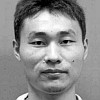 
Zhi-Zhong Chen,
Fei Deng and
Lusheng Wang. Simultaneous Identification of Duplications, Losses, and Lateral Gene Transfers. In TCBB, Vol. 9(5):1515-1528, 2012.
Keywords: duplication, explicit network, FPT, from rooted trees, from species tree, lateral gene transfer, loss, phylogenetic network, phylogeny, reconstruction.
Note: http://www.cs.cityu.edu.hk/~lwang/research/tcbb2012c.pdf.
Toggle abstract
"We give a fixed-parameter algorithm for the problem of enumerating all minimum-cost LCA-reconciliations involving gene duplications, gene losses, and lateral gene transfers (LGTs) for a given species tree S and a given gene tree G. Our algorithm can work for the weighted version of the problem, where the costs of a gene duplication, a gene loss, and an LGT are left to the user's discretion. The algorithm runs in O(m+3 k/c n) time, where m is the number of vertices in S, n is the number of vertices in G, c is the smaller between a gene duplication cost and an LGT cost, and k is the minimum cost of an LCA-reconciliation between S and G. The time complexity is indeed better if the cost of a gene loss is greater than 0. In particular, when the cost of a gene loss is at least 0.614c, the running time of the algorithm is O(m+2.78 k/cn). © 2004-2012 IEEE."
|
|
| |
     
Joel Sjöstrand,
Ali Tofigh,
Vincent Daubin,
Lars Arvestad,
Bengt Sennblad and
Jens Lagergren. A Bayesian Method for Analyzing Lateral Gene Transfer. In Systematic Biology, Vol. 63(3):409-420, 2014.
Keywords: bayesian, duplication, from rooted trees, from sequences, from species tree, lateral gene transfer, loss, phylogenetic network, phylogeny, Program JPrIME-DLTRS, reconstruction.
Note: http://dx.doi.org/10.1093/sysbio/syu007.
|
|
| |
   
Vincent Ranwez,
Celine Scornavacca,
Jean-Philippe Doyon and
Vincent Berry. Inferring gene duplications, transfers and losses can be done in a discrete framework. In JOMB, Vol. 72(7):1811-1844, 2016.
Keywords: duplication, explicit network, from rooted trees, from species tree, lateral gene transfer, loss, phylogenetic network, phylogeny, reconstruction.
|
|
| |
    
Gergely J. Szöllösi,
Adrián Arellano Davín,
Eric Tannier,
Vincent Daubin and
Bastien Boussau. Genome-scale phylogenetic analysis finds extensive gene transfer among fungi. In Philosophical Transactions of the Royal Society of London B: Biological Sciences, Vol. 370(1678):1-11, 2015.
Keywords: duplication, from sequences, lateral gene transfer, loss, phylogenetic network, phylogeny, Program ALE, reconstruction.
Note: http://dx.doi.org/10.1098/rstb.2014.0335.
|
|
| |
    
François Chevenet,
Jean-Philippe Doyon,
Celine Scornavacca,
Edwin Jacox,
Emmanuelle Jousselin and
Vincent Berry. SylvX: a viewer for phylogenetic tree reconciliations. In BIO, Vol. 32(4):608-610, 2016.
Keywords: duplication, explicit network, from rooted trees, from species tree, lateral gene transfer, loss, phylogenetic network, phylogeny, Program SylvX, software, visualization.
Note: https://www.researchgate.net/profile/Emmanuelle_Jousselin/publication/283446016_SylvX_a_viewer_for_phylogenetic_tree_reconciliations/links/5642146108aec448fa621efa.pdf.
|
|
| |
  
Gabriel Cardona,
Joan Carles Pons and
Francesc Rosselló. A reconstruction problem for a class of phylogenetic networks with lateral gene transfers. In ALMOB, Vol. 10(28):1-15, 2015.
Keywords: explicit network, from rooted trees, lateral gene transfer, phylogenetic network, phylogeny, Program LGTnetwork, reconstruction, software, tree-based network.
Note: http://dx.doi.org/10.1186/s13015-015-0059-z.
|
|
| |
 
Misagh Kordi and
Mukul S. Bansal. On the Complexity of Duplication-Transfer-Loss Reconciliation with Non-Binary Gene Trees. In TCBB, Vol. 14(3):587-599, 2017.
Keywords: duplication, from rooted trees, from species tree, lateral gene transfer, loss, NP complete, phylogenetic network, phylogeny, reconstruction.
Note: http://compbio.engr.uconn.edu/papers/Kordi_DTLreconciliationPreprint2015.pdf.
|
|
| |
  
Celine Scornavacca,
Joan Carles Pons and
Gabriel Cardona. Fast algorithm for the reconciliation of gene trees and LGT networks. In JTB, Vol. 418:129-137, 2017.
Keywords: duplication, explicit network, from network, from rooted trees, lateral gene transfer, LGT network, loss, parsimony, phylogenetic network, phylogeny, polynomial, reconstruction.
|
|
| |
  
Edwin Jacox,
Cédric Chauve,
Gergely J. Szöllösi,
Yann Ponty and
Celine Scornavacca. EcceTERA: comprehensive gene tree-species tree reconciliation using parsimony. In BIO, Vol. 32(13):2056-2058, 2016.
Keywords: duplication, explicit network, from rooted trees, from species tree, lateral gene transfer, loss, parsimony, phylogenetic network, phylogeny, polynomial, Program ecceTERA.
Note: https://doi.org/10.1093/bioinformatics/btw105.
|
|
| |
   
Edwin Jacox,
Mathias Weller,
Eric Tannier and
Celine Scornavacca. Resolution and reconciliation of non-binary gene trees with transfers, duplications and losses. In BIO, Vol. 33(7):980-987, 2017.
Keywords: duplication, explicit network, FPT, from rooted trees, from species tree, lateral gene transfer, loss, phylogenetic network, phylogeny, reconstruction.
Note: http://dx.doi.org/10.1093/bioinformatics/btw778.
|
|
|
|
| |
|
| |
|
| |
|
| |
   
Cuong Than,
Derek Ruths,
Hideki Innan and
Luay Nakhleh. Identifiability Issues in Phylogeny-Based Detection of Horizontal Gene Transfer. In Proceedings of the Fourth RECOMB Comparative Genomics Satellite Workshop (RECOMB-CG'06), Vol. 4205:215-229 of LNCS, springer, 2006.
Keywords: explicit network, from rooted trees, from species tree, lateral gene transfer, phylogenetic network, phylogeny, Program LatTrans, Program PhyloNet.
Note: http://www.cs.rice.edu/~nakhleh/Papers/recombcg06-final.pdf.
|
|
| |
   
Bhaskar DasGupta,
Sergio Ferrarini,
Uthra Gopalakrishnan and
Nisha Raj Paryani. Inapproximability results for the lateral gene transfer problem. In Proceedings of the Ninth Italian Conference on Theoretical Computer Science (ICTCS'05), Pages 182-195, springer, 2005.
Keywords: approximation, from rooted trees, from species tree, inapproximability, lateral gene transfer, parsimony, phylogenetic network, phylogeny.
Note: http://www.cs.uic.edu/~dasgupta/resume/publ/papers/ictcs-final.pdf.
|
|
| |
  
Mike Hallett,
Jens Lagergren and
Ali Tofigh. Simultaneous Identification of Duplications and Lateral Transfers. In RECOMB04, Pages 347-356, 2004.
Keywords: duplication, explicit network, FPT, from rooted trees, from species tree, lateral gene transfer, loss, NP complete, parsimony, phylogenetic network, phylogeny, polynomial, reconstruction.
Note: http://www.nada.kth.se/~jensl/p164-hallett.pdf.
|
|
| |
 
Cuong Than and
Luay Nakhleh. SPR-based Tree Reconciliation: Non-binary Trees and Multiple Solutions. In APBC08, Pages 251-260, 2008.
Keywords: evaluation, from rooted trees, lateral gene transfer, phylogenetic network, phylogeny, Program LatTrans, Program PhyloNet, reconstruction, SPR distance.
Note: http://www.cs.rice.edu/~nakhleh/Papers/apbc08.pdf.
|
|
| |
 
Sagi Snir and
Tamir Tuller. Novel Phylogenetic Network Inference by Combining Maximum Likelihood and Hidden Markov Models. In WABI08, Vol. 5251:354-368 of LNCS, springer, 2008.
Keywords: explicit network, from sequences, HMM, lateral gene transfer, likelihood, phylogenetic network, phylogeny, statistical model.
Note: http://dx.doi.org/10.1007/978-3-540-87361-7_30.
Toggle abstract
"Horizontal Gene Transfer (HGT) is the event of transferring genetic material from one lineage in the evolutionary tree to a different lineage. HGT plays a major role in bacterial genome diversification and is a significant mechanism by which bacteria develop resistance to antibiotics. Although the prevailing assumption is of complete HGT, cases of partial HGT (which are also named chimeric HGT) where only part of a gene is horizontally transferred, have also been reported, albeit less frequently. In this work we suggest a new probabilistic model for analyzing and modeling phylogenetic networks, the NET-HMM. This new model captures the biologically realistic assumption that neighboring sites of DNA or amino acid sequences are not independent, which increases the accuracy of the inference. The model describes the phylogenetic network as a Hidden Markov Model (HMM), where each hidden state is related to one of the network's trees. One of the advantages of the NET-HMM is its ability to infer partial HGT as well as complete HGT. We describe the properties of the NET-HMM, devise efficient algorithms for solving a set of problems related to it, and implement them in software. We also provide a novel complementary significance test for evaluating the fitness of a model (NET-HMM) to a given data set. Using NET-HMM we are able to answer interesting biological questions, such as inferring the length of partial HGT's and the affected nucleotides in the genomic sequences, as well as inferring the exact location of HGT events along the tree branches. These advantages are demonstrated through the analysis of synthetical inputs and two different biological inputs. © 2008 Springer-Verlag Berlin Heidelberg."
|
|
| |
  
Cuong Than,
Guohua Jin and
Luay Nakhleh. Integrating Sequence and Topology for Efficient and Accurate Detection of Horizontal Gene Transfer. In Proceedings of the Sixth RECOMB Comparative Genomics Satellite Workshop (RECOMB-CG'08), Vol. 5267:113-127 of LNCS, springer, 2008.
Keywords: bootstrap, explicit network, from rooted trees, from sequences, lateral gene transfer, phylogenetic network, phylogeny, Program Nepal, Program PhyloNet, reconstruction.
Note: http://www.cs.rice.edu/~nakhleh/Papers/recombcg-08.pdf, slides available at http://igm.univ-mlv.fr/RCG08/RCG08slides/Cuong_Than_RCG08.pdf.
|
|
| |

Pawel Górecki. Reconciliation problems for duplication, loss and horizontal gene transfer. In RECOMB04, Pages 316-325, 2004.
Keywords: duplication, explicit network, from rooted trees, from species tree, lateral gene transfer, loss, NP complete, parsimony, phylogenetic network, phylogeny, polynomial, reconstruction.
Note: http://ai.stanford.edu/~serafim/CS374_2004/Papers/Gorecki_Reconciliation.pdf.
|
|
| |

Pawel Górecki. Single step reconciliation algorithm for duplication, loss and horizontal gene transfer model. In ECCB03, 2003.
Keywords: duplication, explicit network, from rooted trees, from species tree, lateral gene transfer, NP complete, parsimony, phylogenetic network, phylogeny, polynomial, reconstruction.
Note: http://www.inra.fr/eccb2003/posters/pdf/short/S_gorecki.ps.
|
|
| |
    
Jean-Philippe Doyon,
Celine Scornavacca,
Konstantin Yu Gorbunov,
Gergely J. Szöllösi,
Vincent Ranwez and
Vincent Berry. An efficient algorithm for gene/species trees parsimonious reconciliation with losses, duplications, and transfers. In Proceedings of the Eighth RECOMB Comparative Genomics Satellite Workshop (RECOMB-CG'10), Vol. 6398:93-108 of LNCS, springer, 2011.
Keywords: branch length, duplication, dynamic programming, explicit network, from multilabeled tree, from species tree, from unrooted trees, lateral gene transfer, loss, phylogenetic network, phylogeny, polynomial, Program Mowgli, reconstruction.
Note: http://www.lirmm.fr/~vberry/Publis/MPR-DoyonEtAl.pdf, software available at http://www.atgc-montpellier.fr/MPR/.
Toggle abstract
"Tree reconciliation methods aim at estimating the evolutionary events that cause discrepancy between gene trees and species trees. We provide a discrete computational model that considers duplications, transfers and losses of genes. The model yields a fast and exact algorithm to infer time consistent and most parsimonious reconciliations. Then we study the conditions under which parsimony is able to accurately infer such events. Overall, it performs well even under realistic rates, transfers being in general less accurately recovered than duplications. An implementation is freely available at http://www.atgc- montpellier.fr/MPR. © 2010 Springer-Verlag."
|
|
| |
  
Mukul S. Bansal,
J. Peter Gogarten and
Ron Shamir. Detecting Highways of Horizontal Gene Transfer. In Proceedings of the Eighth RECOMB Comparative Genomics Satellite Workshop (RECOMB-CG'10), Vol. 6398:109-120 of LNCS, springer, 2011.
Keywords: explicit network, from rooted trees, from species tree, lateral gene transfer, phylogenetic network, phylogeny, polynomial, reconstruction.
Note: http://www.cs.iastate.edu/~bansal/Highways_RCG10.pdf.
Toggle abstract
"In a horizontal gene transfer (HGT) event a gene is transferred between two species that do not share an ancestor-descendant relationship. Typically, no more than a few genes are horizontally transferred between any two species. However, several studies identified pairs of species between which many different genes were horizontally transferred. Such a pair is said to be linked by a highway of gene sharing. We present a method for inferring such highways. Our method is based on the fact that the evolutionary histories of horizontally transferred genes disagree with the corresponding species phylogeny. Specifically, given a set of gene trees and a trusted rooted species tree, each gene tree is first decomposed into its constituent quartet trees and the quartets that are inconsistent with the species tree are identified. Our method finds a pair of species such that a highway between them explains the largest (normalized) fraction of inconsistent quartets. For a problem on n species, our method requires O(n 4) time, which is optimal with respect to the quartets input size. An application of our method to a dataset of 1128 genes from 11 cyanobacterial species, as well as to simulated datasets, illustrates the efficacy of our method. © 2010 Springer-Verlag."
|
|
| |
 
Pawel Górecki and
Jerzy Tiuryn. Inferring evolutionary scenarios in the duplication, loss and horizontal gene transfer model. In Logic and Program Semantics, Vol. 7230:83-105 of LNCS, springer, 2012.
Keywords: duplication, explicit network, lateral gene transfer, loss, phylogenetic network, phylogeny, reconstruction.
Note: http://dx.doi.org/10.1007/978-3-642-29485-3_7.
Toggle abstract
"An H-tree is a formal model of evolutionary scenario. It can be used to represent any processes with gene duplication and loss, horizontal gene transfer (HGT) and speciation events. The model of H-trees, introduced in [26], is an extension of the duplication-loss model (DL-model). Similarly to its ancestor, it has a number of interesting mathematical and biological properties. It is, however, more computationally complex than the DL-model. In this paper, we primarily address the problem of inferring H-trees that are compatible with a given gene tree and a given phylogeny of species with HGTs. These results create a mathematical and computational foundation for a more general and practical problem of inferring HGTs from given gene and species trees with HGTs. We also demonstrate how our model can be used to support HGT hypotheses based on empirical data sets. © 2012 Springer-Verlag Berlin Heidelberg."
|
|
| |
  
Mukul S. Bansal,
Eric J. Alm and
Manolis Kellis. Efficient Algorithms for the Reconciliation Problem with Gene Duplication, Horizontal Transfer, and Loss. In ISMB12, Vol. 28(12):i283-i291 of BIO, 2012.
Keywords: duplication, explicit network, from rooted trees, from species tree, lateral gene transfer, loss, phylogenetic network, phylogeny, Program Angst, Program Mowgli, Program RANGER-DTL, reconstruction.
Note: http://dx.doi.org/10.1093/bioinformatics/bts225.
Toggle abstract
"Motivation: Gene family evolution is driven by evolutionary events such as speciation, gene duplication, horizontal gene transfer and gene loss, and inferring these events in the evolutionary history of a given gene family is a fundamental problem in comparative and evolutionary genomics with numerous important applications. Solving this problem requires the use of a reconciliation framework, where the input consists of a gene family phylogeny and the corresponding species phylogeny, and the goal is to reconcile the two by postulating speciation, gene duplication, horizontal gene transfer and gene loss events. This reconciliation problem is referred to as duplication-transfer-loss (DTL) reconciliation and has been extensively studied in the literature. Yet, even the fastest existing algorithms for DTL reconciliation are too slow for reconciling large gene families and for use in more sophisticated applications such as gene tree or species tree reconstruction.Results: We present two new algorithms for the DTL reconciliation problem that are dramatically faster than existing algorithms, both asymptotically and in practice. We also extend the standard DTL reconciliation model by considering distance-dependent transfer costs, which allow for more accurate reconciliation and give an efficient algorithm for DTL reconciliation under this extended model. We implemented our new algorithms and demonstrated up to 100 000-fold speed-up over existing methods, using both simulated and biological datasets. This dramatic improvement makes it possible to use DTL reconciliation for performing rigorous evolutionary analyses of large gene families and enables its use in advanced reconciliation-based gene and species tree reconstruction methods. © The Author(s) 2012. Published by Oxford University Press."
|
|
| |
    
Maureen Stolzer,
Han Lai,
Minli Xu,
Deepa Sathaye,
Benjamin Vernot and
Dannie Durand. Inferring Duplications, Losses, Transfers, and Incomplete Lineage Sorting with Non-Binary Species Trees. In ECCB12, Vol. 28(18):i409-i415 of BIO, 2012.
Keywords: duplication, explicit network, from rooted trees, lateral gene transfer, loss, phylogenetic network, phylogeny, Program Notung, reconstruction.
Note: http://dx.doi.org/10.1093/bioinformatics/bts386.
Toggle abstract
"Motivation: Gene duplication (D), transfer (T), loss (L) and incomplete lineage sorting (I) are crucial to the evolution of gene families and the emergence of novel functions.The history of these events can be inferred via comparison of gene and species trees, a process called reconciliation, yet current reconciliation algorithms model only a subset of these evolutionary processes. Results: We present an algorithm to reconcile a binary gene tree with a nonbinary species tree under a DTLI parsimony criterion. This is the first reconciliation algorithm to capture all four evolutionary processes driving tree incongruence and the first to reconcile nonbinary species trees with a transfer model. Our algorithm infers all optimal solutions and reports complete, temporally feasible event histories, giving the gene and species lineages in which each event occurred. It is fixed-parameter tractable, with polytime complexity when the maximum species outdegree is fixed. Application of our algorithms to prokaryotic and eukaryotic data show that use of an incomplete event model has substantial impact on the events inferred and resulting biological conclusions. © The Author(s) 2012. Published by Oxford University Press."
|
|
| |
    
Thi-Hau Nguyen,
Jean-Philippe Doyon,
Stéphanie Pointet,
Anne-Muriel Chifolleau Arigon,
Vincent Ranwez and
Vincent Berry. Accounting for Gene Tree Uncertainties Improves Gene Trees and Reconciliation Inference. In WABI12, Vol. 7534:123-134 of LNCS, springer, 2012.
Keywords: duplication, heuristic, lateral gene transfer, phylogenetic network, phylogeny, Program Mowgli, reconstruction.
Note: http://hal.archives-ouvertes.fr/hal-00718347/en/.
Toggle abstract
"We propose a reconciliation heuristic accounting for gene duplications, losses and horizontal transfers that specifically takes into account the uncertainties in the gene tree. Rearrangements are tried for gene tree edges that are weakly supported, and are accepted whenever they improve the reconciliation cost. We prove useful properties on the dynamic programming matrix used to compute reconciliations, which allows to speed-up the tree space exploration when rearrangements are generated by Nearest Neighbor Interchanges (NNI) edit operations. Experimental results on simulated and real data confirm that running times are greatly reduced when considering the above-mentioned optimization in comparison to the naïve rearrangement procedure. Results also show that gene trees modified by such NNI rearrangements are closer to the correct (simulated) trees and lead to more correct event predictions on average. The program is available at http://www.atgc-montpellier.fr/ Mowgli/. © 2012 Springer-Verlag."
|
|
| |
   
Ran Libeskind-Hadas,
Yi-Chieh Wu,
Mukul S. Bansal and
Manolis Kellis. Pareto-optimal phylogenetic tree reconciliation. In ISMB14, Vol. 30:i87-i95 of BIO, 2014.
Keywords: duplication, lateral gene transfer, loss, phylogenetic network, phylogeny, polynomial, Program Xscape, reconstruction.
Note: http://dx.doi.org/10.1093/bioinformatics/btu289.
Toggle abstract
"Motivation: Phylogenetic tree reconciliation is a widely used method for reconstructing the evolutionary histories of gene families and species, hosts and parasites and other dependent pairs of entities. Reconciliation is typically performed using maximum parsimony, in which each evolutionary event type is assigned a cost and the objective is to find a reconciliation of minimum total cost. It is generally understood that reconciliations are sensitive to event costs, but little is understood about the relationship between event costs and solutions. Moreover, choosing appropriate event costs is a notoriously difficult problem. Results: We address this problem by giving an efficient algorithm for computing Pareto-optimal sets of reconciliations, thus providing the first systematic method for understanding the relationship between event costs and reconciliations. This, in turn, results in new techniques for computing event support values and, for cophylogenetic analyses, performing robust statistical tests. We provide new software tools and demonstrate their use on a number of datasets from evolutionary genomic and cophylogenetic studies. © 2014 The Author. Published by Oxford University Press. All rights reserved."
|
|
| |
 
Misagh Kordi and
Mukul S. Bansal. On the Complexity of Duplication-Transfer-Loss Reconciliation with Non-Binary Gene Trees. In ISBRA15, Vol. 9096:187-198 of LNCS, springer, 2015.
Keywords: duplication, from rooted trees, from species tree, lateral gene transfer, loss, NP complete, phylogenetic network, phylogeny, reconstruction.
Note: http://compbio.engr.uconn.edu/papers/Kordi_ISBRA2015.pdf.
|
|
| |
  
Han Lai,
Maureen Stolzer and
Dannie Durand. Fast Heuristics for Resolving Weakly Supported Branches Using Duplication, Transfers, and Losses. In RECOMB-CG17, Vol. 10562:298-320 of LNCS, Springer, 2017.
Keywords: duplication, explicit network, from rooted trees, from species tree, lateral gene transfer, loss, phylogenetic network, phylogeny, Program Notung, reconstruction.
|
|
|
|
 - forked on GitHub.
- forked on GitHub.




















































































